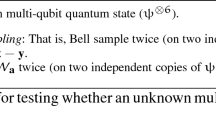Abstract.
This paper describes components of a branch-and-cut algorithm for solving integer linear programs having a large symmetry group. It describes an isomorphism pruning algorithm and variable setting procedures using orbits of the symmetry group. Pruning and orbit computations are performed by backtracking procedures using a Schreier-Sims table for representing the symmetry group. Applications to hard set covering problems, generation of covering designs and error correcting codes are given.
Similar content being viewed by others
References
Avis, D.: A Note on Some Computationally Difficult Set Covering Problems. Mathematical Programming 8, 138–145 (1980)
Butler, G.: Computing in Permutation and Matrix Groups II: Backtrack Algorithm. Mathematics of Computation 39, 671–680 (1982)
Butler, G.: Fundamental Algorithms for Permutation Groups. Lecture Notes in Computer Science 559, Springer, 1991
Butler, G., Cannon, J.J.: Computing in Permutation and Matrix Groups I: Normal Closure, Commutator Subgroups, Series. Mathematics of Computation 39, 663–670 (1982)
Butler, G., Lam, W.H.: A General Backtrack Algorithm for the Isomorphism Problem of Combinatorial Objects. Journal of Symbolic Computation 1, 363–381 (1985)
Conway, J.H., Sloane, N.J.A.: Sphere Packings, Lattices and Groups. Springer, 1993
Feo, T.A., Resende, G.C.: A Probabilistic Heuristic for a Computationally Difficult Set Covering Problem. Operations Research Letters 8, 67–71 (1989)
Fulkerson, D.R., Nemhauser, G.L., Trotter, L.E.: Two Computationally difficult Set Covering Problems That Arise in Computing the 1-width of Incidence Matrices of Steiner Triple Systems. Mathematical Programming Study 2, 72–81 (1974)
Hall, M.: Combinatorial Theory. Wiley, 1986
Jünger, M., Naddef, D., eds.: Computational Combinatorial Optimization. Lecture Notes in Computer Science 2241, Springer, 2001
ILOG CPLEX 7.1 User's Manual, 2001
Elf, M., Gutwenger, C., Jünger, M., Rinaldi, G.: Branch-and-Cut Algorithms for Combinatorial Optimization and their Implementation in ABACUS. In: [10], 155–222
Etzion, T., Wei, V., Zhang, Z.: Bounds on the Sizes of Constant Weight Covering Codes. Designs, Codes and Cryptography 5, 217–239 (1995)
Hoffman, C.M.: Group-Theoretic Algorithms and Graph Isomorphism. Lecture Notes in Computer Science 136, Springer, 1982
Jünger, M., Thienel, S.: Introduction to ABACUS – A Branch-And-Cut System. Operations Research Letters 22, 83–95 (1998)
Kreher, D.L., Stinson, D.R.: Combinatorial Algorithms, Generation, Enumeration, and Search, CRC Press, 1999
Leon, J.S.: On an Algorithm for Finding a Base and a Strong Generating Set for a Group Given by Generating Permutations. Mathematics of Computation 35, 941–974 (1980)
Leon, J.S.: Computing Automorphism Groups of Combinatorial Objects. In: Computational Group Theory, Atkinson M.D. (ed.), Academic Press 1984, pp. 321–335
Luks, E.: Permutation Groups and Polynomial-Time Computation. In: DIMACS Series in Discrete Mathematics and Theoretical Computer Science, 11 1993, Groups and Computation, L. Finkelsein, W. Kantor, eds., 139–175
Mannino, C., Sassano, A.: Solving Hard Set Covering Problems. Operations Research Letters 18, 1–5 (1995)
http://www.ms.uky.edu/∼fmargot/recpub.html
Margot, F.: Small Covering Designs by Branch-and-Cut. Research report 2000-27, Department of Mathematics, University of Kentucky. To appear in Mathematical Programming.
Margot, F.: Pruning by Isomorphism in Branch-and-Cut. Research report 2001-08, Department of Mathematics, University of Kentucky.
Lytsin, S.: An Updated Table of the Best Binary Codes Known. In: Handbook of Coding Theory, V.S. Pless, W.C. Huffmann, eds., North-Holland, Elsevier, 1998
Martin, A.: General Mixed Integer Programming: Computational Issues for Branch-and-Cut Algorithms. In: [10], 1–25
McKay, B.D.: Nauty User's Guide (Version 1.5). Computer Science Department, Australian National University, Canberra
Mills, W.H., Mullin, R.C.: Coverings and Packings. In: Contemporary Design Theory: A collection of Surveys. Dinitz J.H., Stinson D.R., eds., Wiley, 1992, 371–399
Odijk, M.A., van Maaren, H.: Improved Solutions to the Steiner Triple Covering Problem. Information Processing Letters 65, 67–69 (1998)
http://www.oreas.de
Padberg, M.W., Rinaldi, G.: A Branch-and-Cut Algorithm for the Resolution of Large Scale Symmetric Travelling Salesman Problems. SIAM Review 33, 60–100 (1991)
Sherali, H.D., Smith, J.C.: Improving Discrete Model Representations via Symmetry Considerations. Management Science 47, 1396–1407 (2001)
Thienel, S.: ABACUS - A Branch-And-CUt System. Ph.D. Thesis, Universität zu Köln, 1995
Wolsey, L.A.: Integer Programming, Wiley 1998
Author information
Authors and Affiliations
Corresponding author
Additional information
Mathematics Subject Classification (2000): 90C10, 90C27, 90C57
Rights and permissions
About this article
Cite this article
Margot, F. Exploiting orbits in symmetric ILP. Math. Program., Ser. B 98, 3–21 (2003). https://doi.org/10.1007/s10107-003-0394-6
Received:
Accepted:
Published:
Issue Date:
DOI: https://doi.org/10.1007/s10107-003-0394-6




